Watercolour painting is a fun and relaxing hobby that brings enjoyment to artists.
During times like these when millions of people around the world are spending time in quarantine, painting with watercolours has become a popular way to pass the time.
As such, many beginners are learning about watercolour art for the first time. This means that, without proper guidance and instruction, beginner watercolourists may have a hard time learning how to paint.
That’s why, in this article, I’m focusing on explaining:
- 8 important tips that I wish I had known when I was a beginner to help new painters avoid my mistakes
- Which art supplies you should buy for watercolour painting
- The most important skills you need to learn as a newbie
By the time you finish this article, you’ll know which mistakes to avoid as well as the best practices that will help you excel at watercolour.
DISCLOSURE: This page contains affiliate links. If you make a qualified purchase using any of the links, I’ll earn a small commission at no extra cost to you. I appreciate every sale because it allows me to create free content to promote the growth of this website.
Table of Contents
1. Invest in 100% Cotton Paper
As a newbie, I didn’t want to spend too much money on my art supplies because I wanted to be economical.
If I could go back in time, I would invest in high-quality 100% cotton watercolour paper from the start!
You see, cheap paper made of cellulose or wood pulp can’t absorb as much water compared to cotton. What’s more, cheaper paper often buckles, warps, and tears because it’s not as durable as cotton paper.
You see, if you purchase cheap paper, you’re going to make the learning process much more difficult for yourself.
To avoid this, invest in high-quality paper from the beginning, and you’re likelier to have a more enjoyable learning experience.
You can always cut the paper into smaller pieces if you want to make more paintings. As well, you can paint on the back of a painting in order to economize all the space on both sides of the paper.
Here is my best recommendation for 100% cotton watercolour paper:
Arches Cold-Pressed Watercolor Paper
• 100% cotton paper is super water absorbent and ideal for watercolours
• 300 gsm (140 lbs) is thick paper, so it can handle many layers of pigment
• Acid free: Your paper won’t turn yellow
BUY ON AMAZON2. Buy Good Watercolour Brushes
Luckily, as a beginner I did not buy into the watercolour misconception that acrylic brushes can be used for watercolour painting. (This is not true, by the way!)
Instead, I wanted to save money on my supplies. So I bought a cheap set of paintbrushes and believed that was good enough.
Well, it wasn’t.
My cheap brushes did not have fine points, which meant I wasn’t able to create a lot of brushstroke variation and detailing was difficult.
As well, because the synthetic bristles were cheap, they often fell out of the ferrule (the part the bristles connect to), and they became damaged rather easily. It was definitely a frustrating experience.
Since I am now more experienced, here’s my advice for beginners. Invest in 1 – 3 versatile brushes that hold lots of water and paint.
After conducting a lot of research, I invested in the Silver Black Velvet Brushes which are a blend of synthetic and real squirrel hair.
Silver Black Velvet Watercolour Brushes
• Comes with a size 6 round brush, size 12 round brush, and 1 inch flat brush
• Made from a superior blend of squirrel hair and synthetic fibers
• Fine points, soft bristles, and fibers hold a lot of water
BUY ON AMAZONI choose this set for a few reasons:
- Real animal fur is superior in quality because it holds more water and paint, plus the bristles are more durable than synthetic ones
- This particular set had 3 versatile brushes: a ¾ inch brush for laying down large washes, a #8 round brush which is incredibly versatile, and a rigger for fine detailing
- Since the bristles are a blend of real squirrel hair and synthetic bristles, the price point is very affordable without losing any quality
So, if you’re just starting out with watercolour painting, invest in a few good quality brushes. Believe me, you’ll thank yourself later because these brushes will last you a long time.
Note: Synthetic bristles wear down faster and fall apart more easily, which means you’ll have to replace them more often. However, investing in a decent set will work just fine if you paint with gouache.
3. Don’t Rely on Cheap Paint
When I was a beginner, I bought a decent set of student grade paint set. It was a good beginner’s set of paints for an artist on a budget.
But here’s the catch:
Cheaper sets of watercolour paint contain fillers, which means the pigments aren’t pure. As such, companies can justify a lower selling point, which makes the product more affordable.
But when this happens, you sacrifice quality for a happier wallet.
If I could go back in time, I would invest in a set such as the Sennelier L’Aquarelle Watercolors Set of 12 because the paints are professional quality.
Also, the more limited colour palette forces painters to learn how to mix colours. This is advantageous for any painter who’s just starting out because you’ll be forced to learn about colour mixing.
Sennelier L’Aquarelle Watercolors
• 12 tubes with 10ml of pigment, so your paints will last a long time
• Rich and creamy pigments have smooth application
• Layers appear transparent, luminous, and vibrant when they’ve dried
BUY ON AMAZONAs well, professional paints are more transparent, which means they layer better on the paper. The colours are also more vibrant, and they lack the chalky appearance of cheap paints.
But if you prefer watercolour pans, you can check out this set of professional quality White Nights Watercolours.
White Nights Watercolours
• 36 large pans with a diverse range of watercolour pigments
• The vibrant pigments blend easily and have very smooth application
• Box comes with useful and detailed pigment information
BUY ON AMAZON4. Water Control: Water to Paint Ratio
This next tip is imperative when painting with watercolours.
Since watercolour is a painting medium that requires water to activate the paint, you must learn how to balance the ratio of water to paint. If you don’t, a few things might happen:
- You might drench your paper with too much water, which can make the paper buckle and warp
- You might dilute the paint too much, which will thin the colour and cause it to lose its vibrancy
- You might not use enough water, which means the paint will be too dry (watercolour is not the same as acrylic painting!)
In order to avoid these common mistakes that watercolour beginners make, you need to master the water to paint ratio. For this reason, it’s one of the most fundamental skills when learning watercolour painting for beginners.
Like any skill, it takes time and practice to master. Here are a few things you can do to expedite the learning process:
- Warm up by practicing flat and graded washes. Drag the paintbrush across the paper and pay close attention to your wash. If it turns out even, you’re doing a great job. If there’s too much or too little water, adjust accordingly and try again
- Use a spare piece of paper and create many paint marks on the surface. Experiment with different ratios to find a good water to paint balance
- Keep in mind that the paint mixture should be neither too watery nor too dry (unless you’re specifically using the dry brush technique)
Note: As a rule of thumb, try to add enough water to your paint in order to dilute it, but do not add so much water to the paper as to soak it.
I cannot give you an ideal water to paint percentage because it comes down to personal preference and the quality of your paintbrushes and paints.
Ideally, a good amount of water on the paper will create an even sheen.
5. Learn Different Watercolour Techniques
Watercolour painting for beginners often starts with learning some foundational painting skills.
Unfortunately, I didn’t put a lot of effort into learning the different techniques right away because I was just so excited to start painting with watercolours!
However, as a more experienced painter, I understand that it’s better to learn the techniques properly at the beginning in order to develop good painting habits.
As such, it’s important for you to understand how you can use your brush and paints to create different desired effects. For example, here are a few well-known watercolour techniques:
- Wet on wet
- Wet on dry
- Dry brush
- Flat wash
- Graded wash
- Variegated wash
- Lifting
- Glazing
- Splattering
Each technique comes with its own unique abilities and proprieties. Therefore, it’s important that you become familiar with these terms.
Although a breakdown of each technique is beyond the scope of this article, you can refer to this article which breaks down different techniques for watercolour painting.
Use it as a guide to help you learn about painting with watercolours for beginners.
Then make sure you create a variety of paintings in which you can experiment with each individual technique.
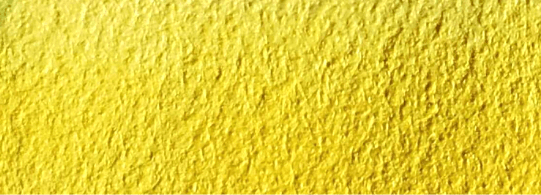
6. Study Colour Theory
If you’re not already familiar with colour theory, now’s the time to start learning about it.
Knowing how to mix colours is an essential skill for any artist. It will also make painting with watercolours easier since you’ll know exactly how to create desirable colours and avoid muddy colours that look flat and dull.
After all, you want to make sure you understand which colours mix to create other colours. You need to know which colours don’t mix well together. And you most certainly want to know how to avoid creating muddy colours.
So, start off by creating a colour chart. Swatch all of your colours and then label them. If you desire, swatch the colours over black ink so that you’re able to test each paint’s transparency.
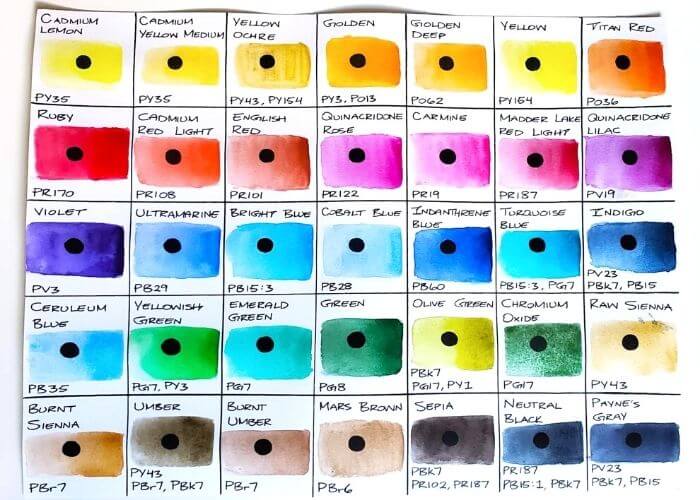
Next, create a colour wheel. For this step, you need to divide a circle into 6ths. Paint the primary colours (red, blue, and yellow) in each section, leaving a white space in between 2 colours.
Then, mix the 2 colours together in the white space to create new colours. You should get orange, purple, and green.
Lastly, you can create a master list of all your colours by creating a grid. In order to do this, label the names of your paints on the horizontal axis and on the vertical axis.
Next, mix each colour in the corresponding square. By doing this, you’re essentially creating a reference chart that showcases every possible colour combination that your palette can create.
Note: If you’re new to colour theory, I recommend that you check out this helpful and simple guide to colour theory.
7. Watercolour Has A Mind of Its Own
This piece of advice is a good tip for painting with watercolours.
You see, watercolour is an unpredictable medium.
As a beginner, it’s hard to accept that you don’t have a lot of control with these art form. Often enough, you find yourself obsessively trying to control where the water flows and how the paint spreads.
But there’s a simple truth here: Watercolour has a mind of its own.
The sooner you accept this truth, the easier it will be for you to deal with artistic perfectionism when it comes to painting with watercolours.
In this way, watercolour is actually a really great medium for anyone who is learning that it’s okay to not be in 100% control of every little thing that happens in your life.
Note: Watercolour often doesn’t work in ways that you want it to. So if you believe you’re not good at painting with watercolours, that’s not true. You just need more experience learning how to let watercolour work in it’s own unique way.
You never really know how a painting is going to turn out. Often, a painting goes through many “ugly” stages before the beauty shines through.
Know that this is perfectly normal. Once you accept the unpredictable nature of watercolour, you’ll also learn how to not overwork your paintings.
If you’re looking for a more thorough guide that breaks down watercolour supplies, techniques, and best practices, check out this post on how to get started with watercolour painting.
8. Wait for the Layers to Dry
The funny thing about watercolour is that, as a beginner, you don’t realize how patient you must be when working with this medium.
Why, you might be wondering?
Well, since you’re working with a wet medium, you must let the layers dry before you begin working on the next layer.
If you don’t, you risk ruining your painting because you could easily muddy the colours or accidentally rub the paint off. Or worse: you might smudge everything with you hand! We don’t want that to happen, right?
In fact, you can click here to check out a night sky watercolour painting tutorial that shows pictures of each individual layer in the painting process. This watercolour tutorial demonstrates the importance of letting layers dry.
So, if you’re an impatient person, you can use a hair dryer or a hand fan to speed up the drying process. If you do this, be careful and make sure that the heat settings aren’t too high and that the air isn’t blowing out too fast.
But if I’m being perfectly honest, the best piece of advice is to be patient.
Developing patience is a great skill not just for watercolourists, but for people in general. Patience forces us to slow down and it teaches us to not expect instant gratification.
What’s more, when you wait for your painting to dry, you can use that time to observe your painting more carefully. It gives you time to consider you next layer. Often, it just gives you time to appreciate your artwork!
Conclusion
All in all, I believe this is the best watercolour advice to help beginner and novice painters avoid some of the mistakes that I made back when I was first learning about painting with watercolours.
Consider what you’ve learned today and use these tips to improve your learning strategies. If you do, I’m sure you’ll have a more enjoyable and fruitful watercolour painting experience!
Good luck with your watercolour painting!
Have you made any of these mistakes? Did I miss any important tips? Share you experience in the comments below!
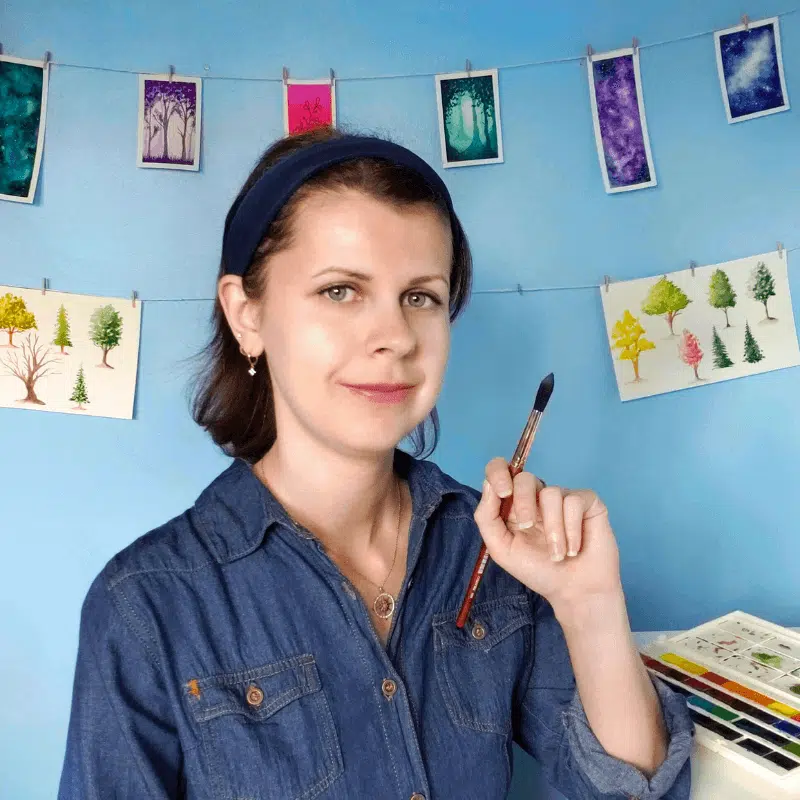
Miranda Balogh
Artist & Online Educator





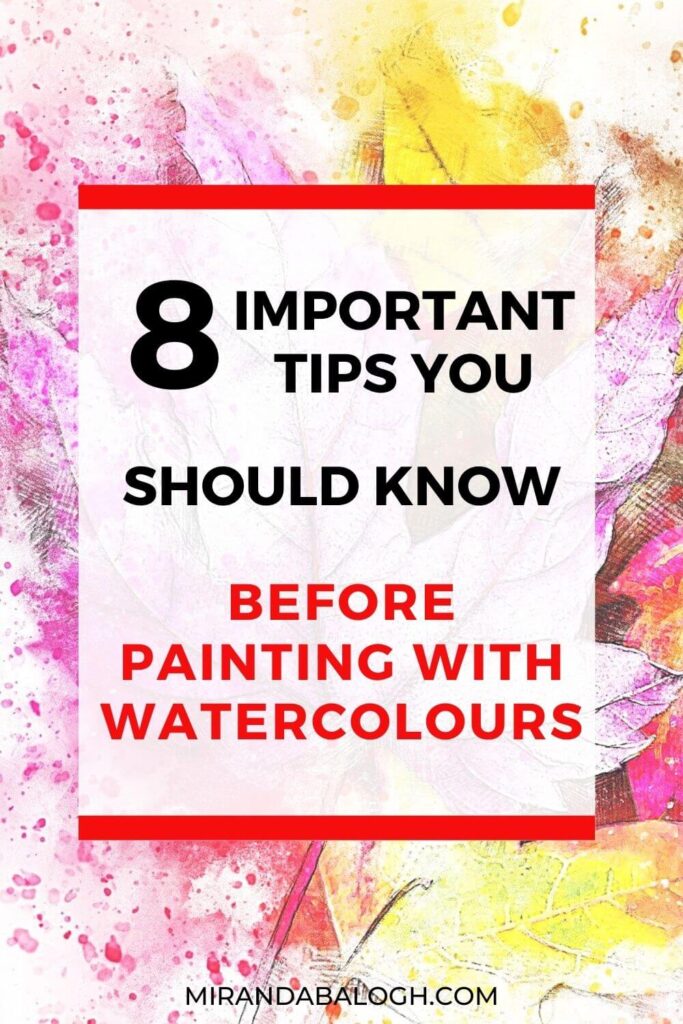
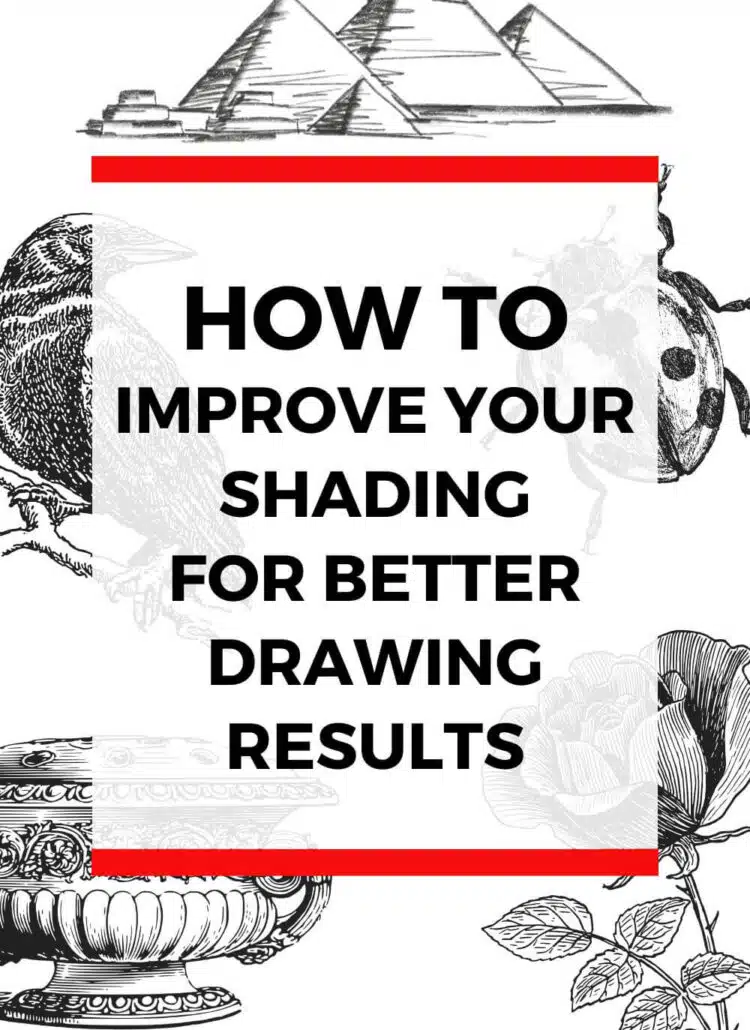
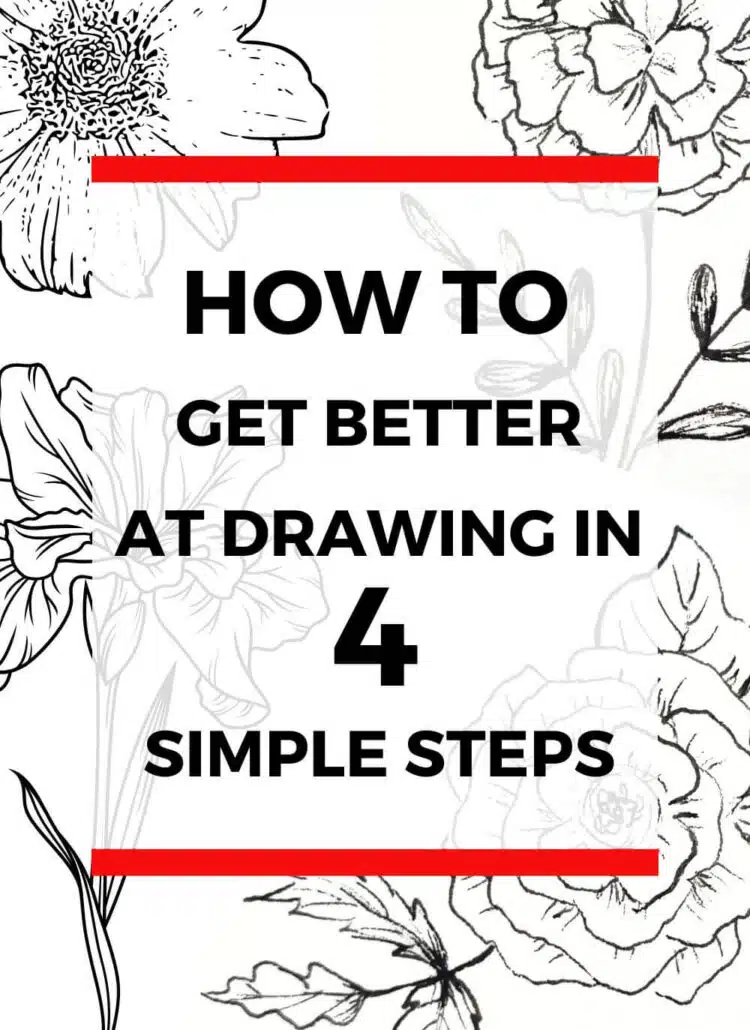


I’ve been picking up my paint brushes again since spending more time at home. I always loved working with watercolors. Thanks for the refresher course.
That’s really awesome! It’s always so nice rediscovering a hobby or passion. Have fun painting with watercolours again!
Thank you so much for sharing these amazing tips and advice. Super helpful 🙂
You’re welcome! I’m glad you enjoyed it.
Very informative. Thanks for sharing.
You’re welcome! I’m glad you enjoyed this post.
I am not the greatest artist. However, this year I am trying to pick up more hobbies, so these tips were great to keep in the back of my mind if I decide to take up watercolor painting. Thank you for sharing!
When it comes to art, I believe you don’t need to be an inherently talented or great artist to enjoy your craft. As long as you enjoy creating, that’s all that really matters. And who knows? With enough practice, you may end up becoming a very skilled artist! Anyway, if you decide to take up watercolour painting, I wish you the best of luck!
Even though I am not a painter myself, these are some great tips! I will send it over to my sister 🙂 Thanks for sharing!
Wow, thank you for sharing this post with your sister! I appreciate it.
These are brilliant tips you’ve provided for a beginner at watercolor painting! My mother is a true expert at watercolor, and I’ve always been curious to try it out. However, I would hardly know where to begin. All of your tips are so helpful, and they’re giving me the courage and confidence to give it a shot. Maybe a New Year’s resolution is forming!
Wow, that would make such a great New Year’s resolution! I’m glad that this article has been able to inspire you with the confidence to consider taking up watercolour painting. I wish you the best of luck should you decide to start painting with watercolours!
Great list and details! I’m just starting to paint (haven’t reached watercolours yet) but his is really good info, even for non water colours. Thanks for sharing!
How exciting! Yes, some of these tips—such as investing in good quality art supplies—work just as well for oil and acrylic painting. Whenever you get around to watercolour painting, feel free to come back to refer to these watercolour tips because they’ll definitely help you out as a beginner!
Very informative post for someone like me who is considering to try painting. This year since lockdown I’ve taken up many new hobbies, though I haven’t tried painting yet. My husband is an artist, and I believe we do have most of the things you mentioned lying around. This is a great reminder that I should try painting this winter. Thanks for sharing.
With winter coming, having a creative hobby such as painting can be such a fun and relaxing activity to do indoors. So definitely give painting a try!
Yay! Love this post. I just started “painting” if you can even it call it that yet – definitely still learning 🙂 this step by step is so helpful!
That’s awesome! I hope you’re enjoying painting. And I’m glad this article was able to help you!
I love watercolor drawings. I’m a beginner and I really enjoyed the part relating to the study of the color scheme. I had never considered it so important. I will try to use it for my future creations, thx
Studying colour theory is a must for beginners! It will help you understand colour harmony as well as how your paints work together. Thanks for sharing!
Thank you for all the great tips! I have been working with water color for about 6 months and felt like I hit a rather large bump in the road until I came across this great post. I am excited to try all your awesome tips! Thank you for everything!!
You’re welcome! In the past, I hit that roadblock with watercolour, too. So I know you’ll get past it soon, just like I did!
It made sense when you mentioned that professional paints layer better on the paper. My friend wants to learn watercoloring. I think it’s best to look for a book that can make watercoloring easy.
Hi Victoria!
There are many awesome watercolour books that you can find by doing a quick Google search. You can also check your local library to see if you can borrow one, or you can find a lot of awesome video tutorials on YouTube that are free.